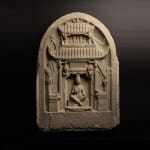Northern Wei Dynasty Sandstone Maitreya in Tushita Palace, 5th Century CE
Stone
108 x 55.9 cm
42 1/2 x 22 in
42 1/2 x 22 in
RL.1027
The stele depicts the Bodhisattva Maitreya in Tushita Palace waiting to descend to the world as the future Buddha. Seated in Padmasana posture, he wears a gentle smile on his...
The stele depicts the Bodhisattva Maitreya in Tushita Palace waiting to descend to the world as the future Buddha. Seated in Padmasana posture, he wears a gentle smile on his face, compassionately looking down to the world from the heavenly palace. He is recognized by wearing a small stupa in his headdress. A scarf is tied around his waist.
Considered the successor to the historical Shakyamuni Buddha, Maitreya is regarded as the Buddha of the Future and presides in the Tushita Heaven until his wisdom is required on earth. By Chinese calculation of the day, the influence of Shakyamuni’s teachings would end in the year AD 552 – roughly 1,000 years after the death of the historical Buddha – ushering in the period of the decline of Buddhist dharma. Such millennial speculation gave rise to the belief that decline and corruption were imminent and that the appearance of Maitreya as the Buddha of the Future could not be far away, which led to a surge in Maitreya’s popularity in the 6th century and the resultant increase in the number of Maitreya images created for worship.
Seated bodhisattvas with their legs crossed at the ankles are among the most ubiquitous images found in the cave-temple complex at Yungang, near Datong, in north Shanxi province. Extensively developed since the Northern Wei Dynasty, both large and small examples were carved on the side walls of many of the caves, as well as on the large central pillars that often filled their interiors. This stele is in very fine condition.
Considered the successor to the historical Shakyamuni Buddha, Maitreya is regarded as the Buddha of the Future and presides in the Tushita Heaven until his wisdom is required on earth. By Chinese calculation of the day, the influence of Shakyamuni’s teachings would end in the year AD 552 – roughly 1,000 years after the death of the historical Buddha – ushering in the period of the decline of Buddhist dharma. Such millennial speculation gave rise to the belief that decline and corruption were imminent and that the appearance of Maitreya as the Buddha of the Future could not be far away, which led to a surge in Maitreya’s popularity in the 6th century and the resultant increase in the number of Maitreya images created for worship.
Seated bodhisattvas with their legs crossed at the ankles are among the most ubiquitous images found in the cave-temple complex at Yungang, near Datong, in north Shanxi province. Extensively developed since the Northern Wei Dynasty, both large and small examples were carved on the side walls of many of the caves, as well as on the large central pillars that often filled their interiors. This stele is in very fine condition.



